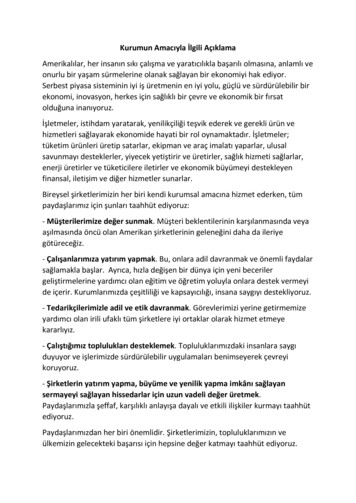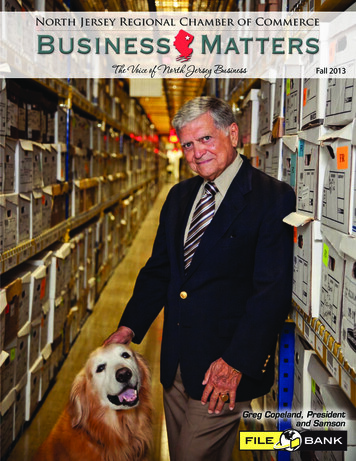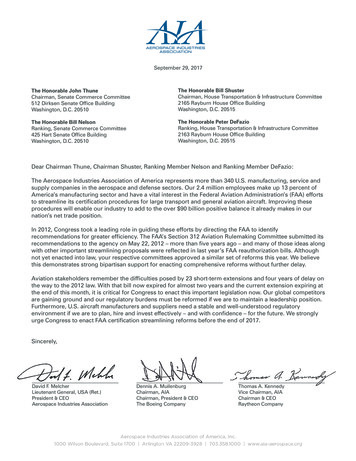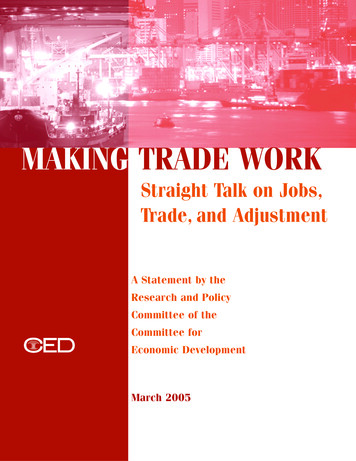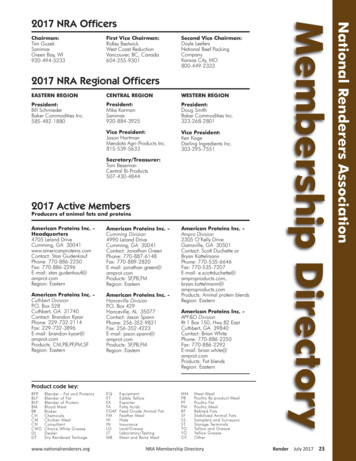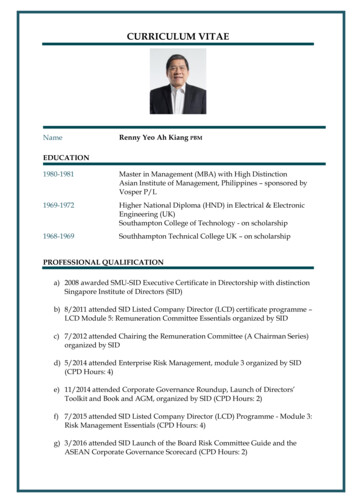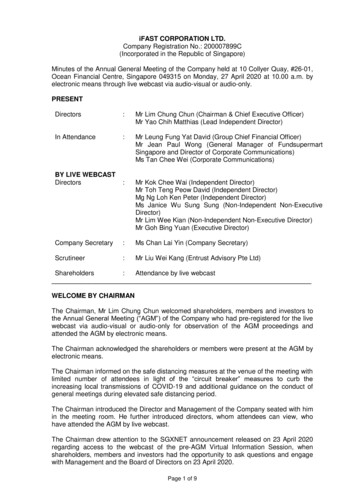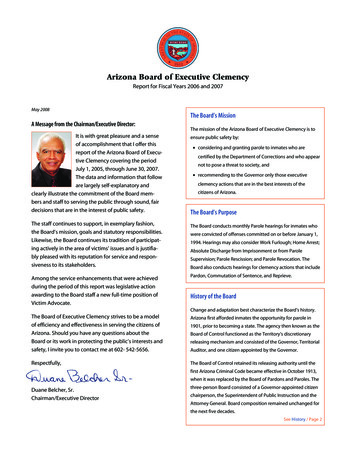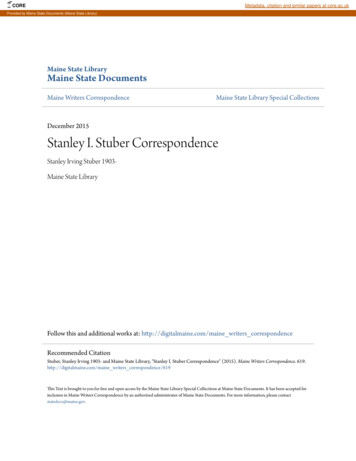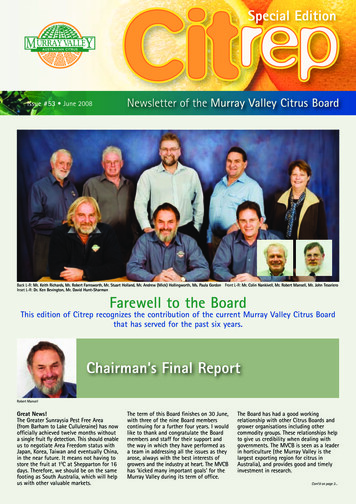
Transcription
Special EditionNewsletter of the Murray Valley Citrus BoardIssue #53 June 2008Back L-R: Mr. Keith Richards, Mr. Robert Farnsworth, Mr. Stuart Holland, Mr. Andrew (Mick) Hollingworth, Ms. Paula Gordon Front L-R: Mr. Colin Nankivell, Mr. Robert Mansell, Mr. John TesorieroInset L-R: Dr. Ken Bevington, Mr. David Hunt-SharmanFarewell to the BoardThis edition of Citrep recognizes the contribution of the current Murray Valley Citrus Boardthat has served for the past six years.Chairman’s Final ReportRobert MansellGreat News!The Greater Sunraysia Pest Free Area(from Barham to Lake Culluleraine) has nowofficially achieved twelve months withouta single fruit fly detection. This should enableus to negotiate Area Freedom status withJapan, Korea, Taiwan and eventually China,in the near future. It means not having tostore the fruit at 10C at Shepparton for 16days. Therefore, we should be on the samefooting as South Australia, which will helpus with other valuable markets.The term of this Board finishes on 30 June,with three of the nine Board memberscontinuing for a further four years. I wouldlike to thank and congratulate the Boardmembers and staff for their support andthe way in which they have performed asa team in addressing all the issues as theyarose, always with the best interests ofgrowers and the industry at heart. The MVCBhas ‘kicked many important goals’ for theMurray Valley during its term of office.The Board has had a good workingrelationship with other Citrus Boards andgrower organisations including othercommodity groups. These relationships helpto give us credibility when dealing withgovernments. The MVCB is seen as a leaderin horticulture (the Murray Valley is thelargest exporting region for citrus inAustralia), and provides good and timelyinvestment in research.Cont’d on page 2.
2Inside this issue:P1 Chairman’s Farewell ReportP2 Chief Executive’s ReportP3 Beware of Frost Damage toCitrus FruitsNewsletter of the Murray Valley Citrus BoardChief Executive’s ReportJohn TesorieroP4 Making of the Murray ValleyCitrus Board OrderP5 The Murray Valley Citrus Board(MVCB) and its Key Areas ofOperation, Performance andAchievementsP7 Notes From Neil Eagle Ms Marian Tobin RetiresP8 FEATURE ARTICLE:Robert MansellP11 MVCB Product Price ListP12 Sunraysia Citrus Growers ReportP13 Profile - Colin NankivellP14 Harvest Picnic at Hanging RockP15 SunRISE 21 Mapping - June 2008Chairman’s Farewell ReportCont’d.I will not be continuing as a Boardmember, so I would like to take thisopportunity to wish the new Board andstaff my very best wishes for the future.I would like to thank Eddie and NancyeWarhurst for their efforts in makingthe Citrep a very readable publicationand for their patience in encouragingme (sometimes at the last minute) topresent my reports.Here’s hoping for rain in the catchments.(40 days and 40 nights).Robert Mansell Chairman,MVCBA valuable opportunity presented itself at short notice in Aprilfor me to join a trade delegation to Japan, Hong Kong, Koreaand China with the Federal Agriculture Minister Tony Burkeand his advisors. Mr Jeff Scott, Chief Executive, AustralianTable Grape Association was also a participant in the visit.(L-R) Jeff Scott, Chief Executive, Australian Table Grape Assoc Inc.; Hon Tony Burke, MP, Minister for Agriculture, Fisheries andForestry; John Tesoriero, Chief Executive, MVCB.The main purpose of the delegation froma citrus industry perspective was to discussseasonal fruit fly area freedom (June- December) for citrus export to Japan fromthe Greater Sunraysia Pest Free Area (PFA).extremely worthwhile. It highlighted toour trading partners the importance thegovernment places on trade in horticultureand provided an excellent networkingopportunity for industry participants.In addition, discussions were held withChinese quarantine officials aimed atamending the current citrus export protocol.Throughout the visit, we were invited toall the ministerial functions.With regard to China, we are seekingrecognition of a systems approach to themanagement of Fuller’s Rose Weevil in lieuof the current orchard freedom requirement;adoption of 2 to 3ºC for cold treatment;recognition of inland Pest Free Areas;access to southern Chinese Ports; andremoval of the requirement for recalibrationof temperature probes on arrival.In relation to Japan, it is pleasing thatAustralia has now satisfied all of Japan’srequests for information on the GreaterSunraysia PFA.It is proposed that Japan will conduct averification visit to our region in mid tolate May 2008 that will, hopefully, finalisethe issue of seasonal area freedom forexports to Japan from our PFA. Chinesequarantine officials indicated that they wereconsidering our requests for amendmentof the current protocol and that anyamendment would be science based.However, no indication was given re atime frame for further consultation and/ora decision at this stage.Being part of the trade delegation withthe Minister and his key advisers wasThe Minister was pushing Australian tablegrapes and citrus in all of his keynotespeeches, and we were often asked to followhis presentation outlining our industryissues about market access, overviewsabout food safety and quality, guaranteeof supply and how important their marketswere to Australia.His key focus was the world food shortage,Australian food safety reputation, climatechange and our Australian clean and greenproduction.You couldn’t put a value on our networkingand interaction with Minister Burke andhis advisers over those two weeks.Some concern was expressed that Australiancitrus could flood the Japanese market, butour volume of exports will not allow thatto happen. The Minister was very strongon that point.Overall, the visitation was timely and veryworthwhile.John Tesoriero Chief Executive,MVCB
Newsletter of the Murray Valley Citrus Board3Beware of Frost Damage to Citrus FruitsNow that winter is here, growers need to be aware of the potential for frost damageto their fruit.within the fruit. Assess the whole patchrandomly by cutting numerous fruit fromthe outer canopy in the lower and upperparts of both sides of the tree; sample atleast 50 fruit per patch. Begin by cuttingsmall fruit and if frost damage is foundmove onto larger fruit.Photo #2Fruit slicedopen forinspection.Photo #1 Frost Damage to fruit centres.Frosts occur on cloudless nights when clearskies allow heat to be lost rapidly from soiland plant surfaces. They can be particularlysevere if this is combined with windlessconditions, as cold air near ground leveldoes not mix with warmer air higher up.amount of heat absorbed by the soil duringthe day, should be removed or closely mowed.This also applies to cover crops. Damp soilsstore more heat during the day and morereadily conduct heat to the surface. Heatconduction is better in compact soils.Frost damage is a time and temperaturerelationship. Ripe citrus pulp freezes atabout -1.90C to -3.90C. If air temperatureis below -20C for only a short time, fruitdoes not freeze because enough heat isstored in their mass to prevent it. Immaturefruit is more vulnerable to damage thanmature fruit. As fruit ripens, its sugarcontent increases, producing a moreconcentrated solution that has a lowerfreezing point. Smaller, mature fruit willfreeze more quickly than larger mature fruit,as the store of heat energy in smaller fruitis less.Look for areas with external fruit and shootburn to help identify frosted areas. Externalfruit damage such as a water soaked rindor ruptured oil glands can occur within1 to 14 days after a frost. However, fruitmay have internal damage without anyexternal signs. Internal damage to fruitcan be identified a day or two after a frostby the water-soaked appearance inside.However, it may take up to 14 days forinternal damage to be expressed.If the temperature drops to -20C for 4 hoursor more, growers need to check theirorchards for frost-damaged fruit. Damageis more likely to occur the longer fruit isexposed to this threshold. Low lying areas,especially those near unirrigated land, andends of rows (depending on topography)are usually affected first. A bare, damp,compact soil is the best protection againstfrost. Weeds, because they reduce theEarly symptoms of internal frost damageare ruptured juice sacs and pale centres.As the juice forms ice crystals, it expandsin volume and ruptures the juice sackscausing internal damage. The juice leaksout and eventually evaporates through therind. Portions of the fruit dry out with mostdamage seen in the centre as illustratedin Photo #1.To check if internal damage has occurred,slice fruit early on the morning frost hasoccurred to identify if ice has formedSlice some known unaffected fruit first tocalibrate your eye for differences. Use asharp knife, preferably with a blade longerthan the width of the fruit. Cut fruit inabout four separate slices to assess thewhole of the fruit as shown in Photo #2.Taste suspected frost damaged fruit as itwill have an ‘off’ flavour.If frost damage is found in an isolatedarea only, continue sampling to define thesection where frost damage has occurredand tape this area off. Record the patchand the number of damaged fruit (eg 2 in100) with the date in your diary for futurereference.The greatest danger when frost damageoccurs at full harvest is the temptationto pick immediately. If you suspect frostdamage has occurred, suspend harvestoperations and communicate with yourpacking house. Re-assess the orchard forfrost damage by cutting fruit at regularshort intervals, for a period of at least twoweeks. Damage may be apparent after oneweek and symptoms become more visibleas time progresses.Don’t be tempted to send frost-damagedfruit to your packer, as you may end upwith a bill. Frost damaged fruit on themarket not only undermines consumerconfidence in the Australian citrus industry,it will also affect market prices forundamaged fruit.Mary Cannard IDO, MVCB
4Newsletter of the Murray Valley Citrus BoardMaking of the Murray Valley Citrus Board OrderA Brief OverviewThe Murray Valley Citrus Board’s four-year term is about to expire. Consequently, it isup to growers to decide if they want to see the Board continue to operate and provideindustry-based services to growers.The Minister for Agriculture, the Hon JoeHelper MP, received a petition from MurrayValley citrus producers (SCG and MMCG)requesting that the Murray Valley CitrusBoard (MVCB) be remade under the provisionsof the Agriculture Industry DevelopmentAct (AIDA) 1990, for a further four yearterm, from 1 July 2008 to 30 June 2012.To discuss this important issue, Mr KevinCock, representing SCG Inc. welcomedparticipants to a consultative meeting inMildura on 3 April, 2008. This followed asimilar meeting held in Barham, NSW theday before.The key issue for discussion was to considerthe remaking of the Murray Valley CitrusBoard Order. The Order was defined as alegislated way of raising money from anindustry in a defined area, from a definedsector of the industry and for a definedpurpose (eg R and D, extension, marketinformation etc).It also provides for the establishment ofan Industry Development Committee (IDC)- nominated by industry to deliver theseservices. (The Committee comprises industrypersonnel plus Government representatives.)Mr Stuart Holland, DPI Victoria andGovernment nominee on the MVCB,explained the process and gave somebackground of the Order and an IDC. Heoutlined the key features of the Order andthe Committee structure. An IDC gives legalauthority to raise a charge for industryspecific services to undertake activitiesagreed to by the industry. An IDC onlyexists if industry votes for it.Stuart then outlined how an IDC operates(including the key section of the functionof the Board over a four year term)together with sources of income.Mr Robert Mansell, Chairman, MVCBpresented the key highlights of the currentBoard’s activities to date. Specific referencewas made to 2005 activities and furtherinitiatives taken in 2006 and 2007.The extensive number of projects andprograms undertaken was aptly summarisedwhen Robert stated that ‘the office isalways extremely busy’.Ms Mary Cannard, Industry DevelopmentOfficer, MVCB gave a summary of the keyprojects undertaken. These fell under theprogram summary headings of encouraginggreater uptake of best practise and innovativetechnology, the provision of high qualityindustry data and the development of genericand targeted promotional strategies.The MVCB key projects included the ‘Impacton Citrus Leadership Project’, IndustryDevelopment Officer and CittgroupCo-ordinator, Pest Free Area - GreaterSunraysia, Tri-State Fruit Fly CommunityAwareness Program, increased selectionefficiency in the national Citrus ScionBreeding Program, the Agrilate Projectand the establishment of Citrus Gall Waspparasite in the Sunraysia region.Finally, the case for and against the proposalwas outlined and included potential andcomparative costs.The polling and voting procedure was alsomade clear noting: The proposal on which citrus growersmust vote Eligibility to vote Polling and voting arrangements andtimeframesThe result of the poll will be determined bya simple majority of valid votes counted.The Victorian Minister for Agriculture willthen give consideration to the poll resultsand the feedback into the report anddecide on the remaking of the Order.Questions from the floor were then taken.Some points raised were: The importance of having a good turnoutat the poll. Not allowing apathy to get in the wayof this happening. The Board and staff have providedvaluable service to the needs of growersand deliver it well. If the Board doesn’t continue, where willgrowers get such essential services?In closing the meeting, Kevin Cock paidtribute to the current Chairman of the MVCB.Robert Mansell had spent 19 years on theBoard, the last 6 as Chairman, and hiscommitment to the industry was significantand appreciated by all. The comments wereacknowledged with acclamation.E. Warhurst CompilerSTOP PRESSThe voting process hasnow concluded. If thetotal vote was positive,Victoria and New SouthWales would be ready togazette on 27 June 2008for the Order to be put inplace from 1 July 2008.
Newsletter of the Murray Valley Citrus Board5The Murray Valley Citrus Board (MVCB)and its Key Areas of Operation, Performanceand AchievementsThe following is a summary of the current MVCB’s operations over the past three to fouryears. It clearly indicates that the Board can look back with a deserved measure of pridein its achievements in servicing the citrus industry, locally and beyond.This section describes the key areas of MVCB operation over the last 3-4 years and outlinesa proposed direction for a new four year term of operation from 1 July 2008.Role In Current Water ShortageThe current water supply position continuesas a significant threat, not only for citrusproducers, but also all horticulturalproduction throughout the Murray Valley.To brief producers on the situation, theMVCB facilitated an important water forumat the Coomealla Club, Dareton on23 November, 2006. In excess of 240producers attended the forum.MVCB also played a major role in securingcritical needs water for New South Walescitrus producers from July, 2007 to March2008. This was achieved through effectiveadvocacy with the NSW government andthe Department of Water and Energy.MVCB’s Planting Statistics Data Base provedinvaluable for determining water allocationsto producers based on plant requirements(bearing, non-bearing trees etc).Response To The Severe Frost EventSevere frost events throughout the MurrayValley in May and June 2006 had a majorimpact on production in 2006/07. The lastfrost event of similar magnitude occurredin 1982. Temperatures plummeted to -110Cand -140C on some citrus properties in theNangiloc/Colignan area of Victoria whereapproximately 65% of Murray Valley citrusproduction occurs. The damage to individualproperties varied from none to significant,depending on the location of the orchard.A conservative estimate of the damagewas lost citrus production of 16,000 tonnes.In response to the frost event, the MVCBconducted frost damage assessmentworkshops throughout the region. Theworkshops demonstrated to growers asampling method to identify and isolatewhere internal fruit damage occurred,enabling producers to harvest with someconfidence.The industry was pleased to note that therewere very few incidents of frost-damagedfruit reaching the market.Market Access ActivitiesArea freedom status (fruit fly freedom) forJapan, Taiwan and Korea remains a highpriority for Murray Valley producers andexporters. The criteria for gaining initialarea freedom is 12 months free of any fruitfly detection. However, within two monthsof achieving the benchmark 12 monthsfor Japan, two wild flies were detected intraps in Mildura in March 2007, and thiswas followed by a further two detectionsin Mildura in May 2007. While notconstituting an outbreak, the detectionsthwarted initial efforts to gain area freedomfor this important market. Despite theseproblems it is significant that Indonesiahas reinstated area freedom for MurrayValley citrus exports.In October 2005, Australian citrus producersgained official market access to the People’sRepublic of China. However, the protocolas it relates to orchard freedom from Fuller’sRose Weevil (FRW) is proving a major barrierto trade and is unworkable for southernAustralian regions. Queensland, on theother hand, was able to export about 19containers of mandarins to China duringthe year.In an attempt to overcome this difficultprotocol, the MVCB approached the formerFederal Minister for Agriculture, Fisheriesand Forestry, The Hon. Peter McGauranwith a request for assistance. The Ministerindicated a willingness to fund relevantFRW research. The MVCB responded byundertaking a study into previous FRWresearch, and coordinated a workshop ofresearchers to develop strategies to controlor manage FRW in the orchard.This resulted in three funding applicationsbeing submitted to Horticulture AustraliaLtd (HAL); two dealing with post harvesttreatment and the other with orchardcontrol strategies and research. All threeprojects have now been approved. (Totalbudget, 1.2 million).Industry remains hopeful of a favourableoutcome when the protocol is renegotiated.This process commenced in October 2007.A successful outcome will probably requirea systems approach to the management ofFRW, requiring a combination of orchardand post harvest treatments, rather thantrying to meet orchard freedom from thispest which is considered virtually impossible.MVCB Leadership ProgramThe MVCB ran a second Impact on Citrusprogram conducted by Leading Industriesearly in 2007. Ten young citrus industryparticipants passed the leadership trainingprogram and presented their projects toThe Hon. Sussan Ley, (former) ParliamentarySecretary to Minister McGauran, FederalMinister for Agriculture, Fisheries andForestry. These young people are consideredfuture leaders of the industry and we lookforward to their on-going involvement inthe citrus industry.Support for State and NationalPromotionsThe MVCB provided support to the NationalPromotions Committee through committeemembership and strategic advice.Cont’d.
6Newsletter of the Murray Valley Citrus BoardThe Murray Valley Citrus Board (MVCB) and its Key Areas of Operation,Performance and Achievements Cont’d.Mick Hollingworth and John Tesorierorepresented MVCB on the NationalCommittee.The MVCB also continued to support theMelbourne Citrus Committee with itspromotions, e.g. Athletics Victoria and theschool programs. Both these promotionalprograms aim to encourage the greaterconsumption of citrus.Role in Establishment andOperation of Pest Free AreaThe MVCB and the citrus industry haveplayed a key role in a partnership to developa new Pest Free Area (PFA) strategy for theSunraysia district. This partnership includesthe stone fruit and table grape industries,Department of Primary Industries (DPI)Victoria and the NSW Department ofPrimary Industries. Nearly 1.5 million hasbeen invested in this initiative, the bulkof which has come from DPI Victoria withadditional resources from industry andHorticulture Australia Ltd. (HAL). The MVCBand the other two industry bodies jointlysought and won agreement for HAL toprovide some of the industry investment inthe project. The MVCB manages the interestsof the citrus industry for this project, themanagement committee of which is chairedby Mr Peter Bailey from DPI Victoria.A Memorandum of Understanding has beensigned setting out project management andco-funding arrangements. A company hasbeen appointed for two years to createpublic awareness of the new PFA. The PFAcreates a boundary around production areasthat are internationally recognised as freefrom fruit fly. The Greater Sunraysia PFAstretches from Lake Cullulleraine to east ofBarham on the Murray River. This boundaryis within the Fruit Fly Exclusion Zone (FFEZ)and means that the area can be managedmuch more effectively. This also givesDPI Victoria the ability to control fruitmovement within the PFA borders and putroadblocks just outside the boundaries wherethey can inspect travellers, confiscate fruitand impose fines on anyone carrying fruitillegally.Advocacy and AdviceThe MVCB advised Federal and StateParliamentarians regarding the critical needfor water for citrus in July, August andSeptember 2007. During 2007, the MVCBalso met with: Federal Minister for Agriculture, Fisheriesand Forestry, The Hon. Peter McGauranand his Parliamentary Secretary The Hon.Sussan Ley; Victorian Community Cabinet in Mildura; Victorian Minister for Agriculture,Joe Helper MP; and Victorian Minister for Water, Environmentand Climate Change, John Thwaites MP.Strategic DirectionThe strategic direction of the MVCB sincethe re-organisation in 1990, has addressedthe need for varietal adjustment away fromheavy reliance on fruit processing, tobecome more internationally competitiveand focussed on fresh fruit exports. TheMVCB projects and programs are aimedat facilitating citrus production at “worldbest practice” levels under a number ofpriority programs, which are reviewed andupdated annually under the MVCB’s fouryear plan of operations.Many of these ‘industry development’ andR&D projects are undertaken in co-operationwith industry partners such as HAL, CSIRO,NSW DPI and DPI Victoria, enablingconsiderable advantages from cost sharingand/or leveraging of funds. Annually, theMVCB has typically attracted more than35% of its budget from sources other thancompulsory charges on Murray Valleygrowers.Examples of these projects are the CitrusInformation Technology Transfer Groups(CITTgroups) with a national network ofregional co-ordinators in all the majorcitrus growing areas. Since their inceptionin 1995, an average of 15 CITTgroupactivities have been held in the MurrayValley annually. Their objective is to conveyknowledge to improve on-farm practicesin an informal way, by utilising experts intheir fields from Australia and overseas.These events included farm walks, workshopsand/or meetings and have been wellattended by growers with very positiveresponses.Recent CITTgroup topics have included: Oleocellosis Prediction Tools and theiruse in the Field Pruning and Hedging Strategies forDrought Conditions Managing a Citrus Business when theRiver Dries Up Drought Assistance (Federal and State)Workshop Crop Manipulation for Fruit Size- Corasil Application, Chemical andMechanical Thinning.PROPOSED PROGRAMS/PROJECTSFOR 2008/09These have been prepared to outline aproposed direction for a new four yearterm from 1 July, 2008.The plan of operations has been preparedtaking into consideration the crop forecastfigures for the 2008/09 season. The forecastindicates a crop of 104,778 tonnes, areduction of 23% from that forecast for2007/08 (134,610). This has resulted inthe MVCB levy income being reduced byapproximately 190,000.With the above in mind, the MVCB’sstrategic direction for 2008/09 has beendeveloped in close collaboration with theregional citrus organizations and will followon from the work undertaken in previousyears.
7Newsletter of the Murray Valley Citrus BoardFrom Neil EagleNeil EagleAt the time of writing, the long awaited autumn break has not eventuated and the weatherforecasters are talking down the prospects until possibly the spring of this year.Fortunately, the water in storage is slightlyahead of last year at this time and essentialwater for towns, stock and domestic is instore. Thus, the inflows should be availablemore quickly as allocation than was thecase last year.In regard to the Industry RestructureProposal to be put forward immediatelyfollowing the ACG Annual Meeting on29 May, 2008: The proposals are driven by the desire tomaximize the benefits to growers of theexpenditure of their levy contributionsby streamlining the peak body ACG, andto eliminate any duplication of effortsby closer cohesion with our regionalbodies, both grower and statutory. I urge growers to actively participatein these ongoing discussions so thatdecisions are made that are widelyendorsed by growers.Finally, I would like to thank all membersof the outgoing Murray Valley Citrus Board,chaired by Robert Mansell, for theirconsiderable efforts on our behalf over anumber of years. I thank the nominees ofthe incoming Board for having nominatedand wish them all the best. I trust thattheir endeavours on our behalf will berewarding to them and beneficial to ourgrowers.Neil Eagle Chairman,Mid-Murray Citrus Growers IncMs Marian Tobin RetiresA relaxed and thoroughly enjoyable occasion was held on Friday, 14 March 2008 to markthe retirement of Ms Marian Tobin, Personal Assistant to the CEO, from the MVCB.Marian has completed nine years of dedicatedservice to the organization and the eveningreflected the high regard in which she isheld by the Board, her work and businesscolleagues, friends and the community atlarge.of thanks included fellow staff members(past and present) growers and the relevantsectors within the citrus industry. She alsoreminisced in an enjoyable way of hervaried employment opportunities leadingto her appointment at the MVCB.was invaluable. As compiler, I commend herefficiency, courtesy and attention to detailand remain indebted to her for theaccumulated knowledge of the citrusindustry and the key roles of the MVCBthat she always had at her fingertips.Chairman, MVCB, Robert Mansellacknowledged that Marian was theconsummate professional and hercommitment and sense of occasion hadearned the respect of all. These sentimentswere further echoed by Mr Kevin Cock,Mr John Braniff, Mr John Tesoriero,Mr Peter Crisp, MLA, Member for Milduraand other contributors.Clearly, Marian set high personal andprofessional standards in her attitude towork. Her depth of practical experienceand common sense approach underpinnedher comments and observations.Every best wish is extended to Marianand her husband Des for a long, relaxingand healthy retirement. The hope is thatthey will now have time to do some of thethings they want to do.At this stage, Marian will continue tomaintain some contact with the MVCBby remaining responsible for compilingthe Board Minutes.In all, the retirement occasion was a genuineand deserved acknowledgement of a jobvery well done in the interests of the citrusindustry.Marian Tobin’s constructive involvementin the preparation of the Citrep magazineE. Warhurst CompilerIn her response, Marian Tobin expressed herappreciation to the Board and those she hadworked closely with over the years. This vote
8Newsletter of the Murray Valley Citrus BoardRobert MRobert Mansell, Chairman,MVCB, was initially reluctantto agree to my request tobe interviewed for a majorCitrep article.This response was typicalof the man, as I have cometo know him. Robert wasthere to work, not to seekpersonal publicity.Robert has had 19 years involvement withthe MVCB. This means that he has playeda significant part in its history and such anoutstanding commitment deserves to beformally recognised.‘I became involved in the Citrus IndustryOrganisations in my early twenties. At thattime we had the ACGF (Australian CitrusGrowers Federation) as the peak body. TheSunraysia and Districts Citrus Co-operativeSociety Ltd (SDCCS) was our regionalbranch (forerunner of SCG) at the time.In the 1970’s, the Nangiloc Branch wasone of the most active branches and myfather suggested it was time I becameinvolved in industry matters. The Nangilocregion was a relatively new horticulturalarea, so there were a lot of vegetables stillbeing grown and growers were using theMelbourne Wholesale Market growerssection to sell their vegetables and citrus.Sadly, the Branches don’t exist any longer,as they were a good training ground forunderstanding the issues and how industrypolitics work.’Robert became Secretary of the NangilocBranch and later was nominated as amember of the Advisory Central Council(ACC) advising the Directors of SDCCS.He was the secretary for some time anddescribes it as ‘real agri-political’.‘When the Murray Valley Citrus MarketingAct, 1989 was passed to enable the twoState Boards to be enacted, I was approachedto nominate for a position as a Boardmember on the Murray Valley CitrusMarketing Board. I have to say that I didn’tbelieve I had any of the skills required tobe a Board member, believing that was forolder people with a better education thanI had. However, I was convinced to at leasthave a go and when I was asked to attendan interview with the 5 member selectionpanel I didn’t feel very comfortable. Theinterview was the toughest thing I hadever done.’During my discussions with Robert, hiscomments and observations reflected adepth of knowledge, extensive networksand experience of all sectors of the industry.He considered that he was helped in hisrole by being a packer as well as a grower.He stated that an organization like theMVCB is necessary to represent growerinterests by being
packing house. Re-assess the orchard for frost damage by cutting fruit at regular short intervals, for a period of at least two weeks. Damage may be apparent after one week and symptoms become more visible as time progresses. Don't be tempted to send frost-damaged fruit to your packer, as you may end up with a bill. Frost damaged fruit on the
